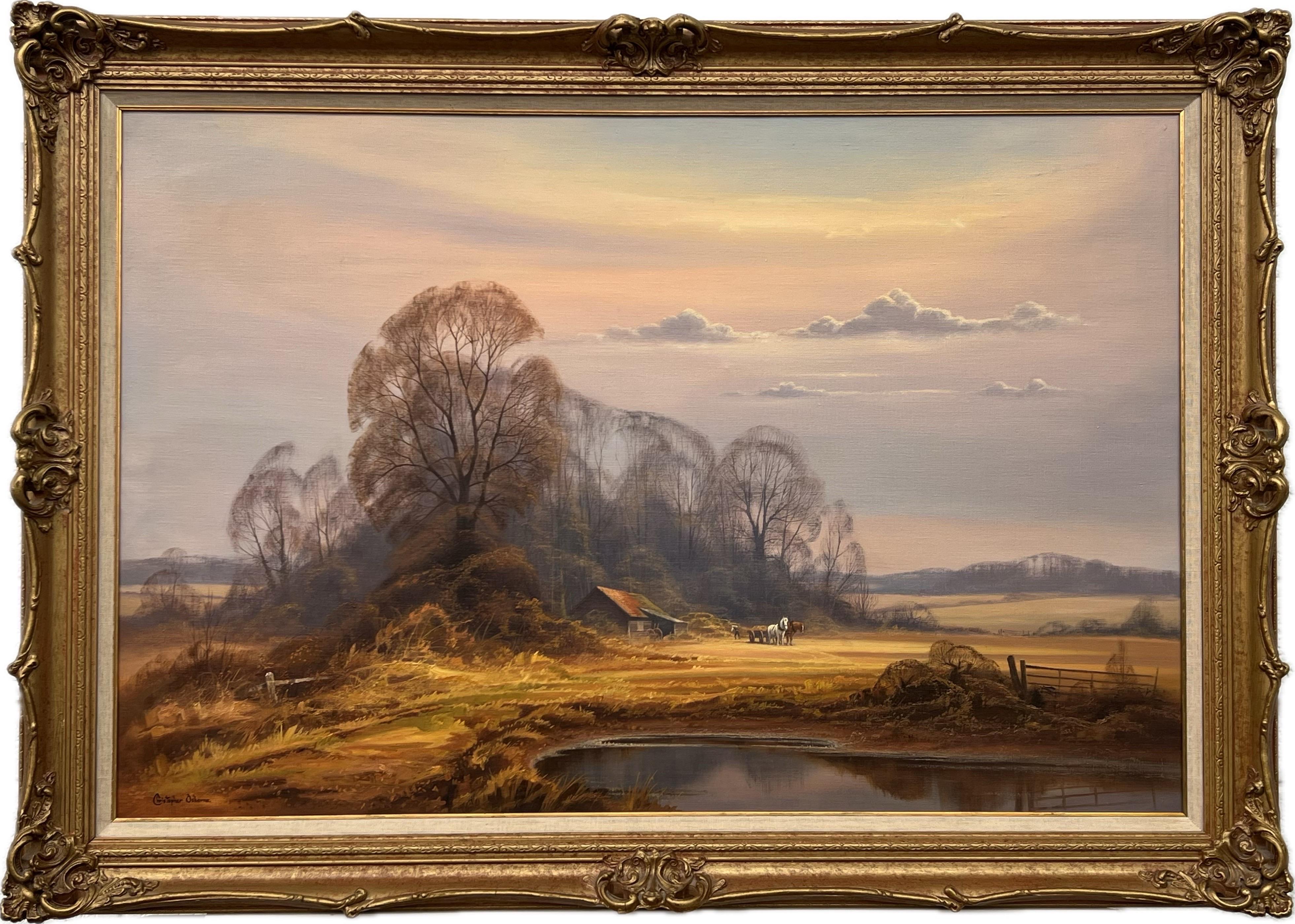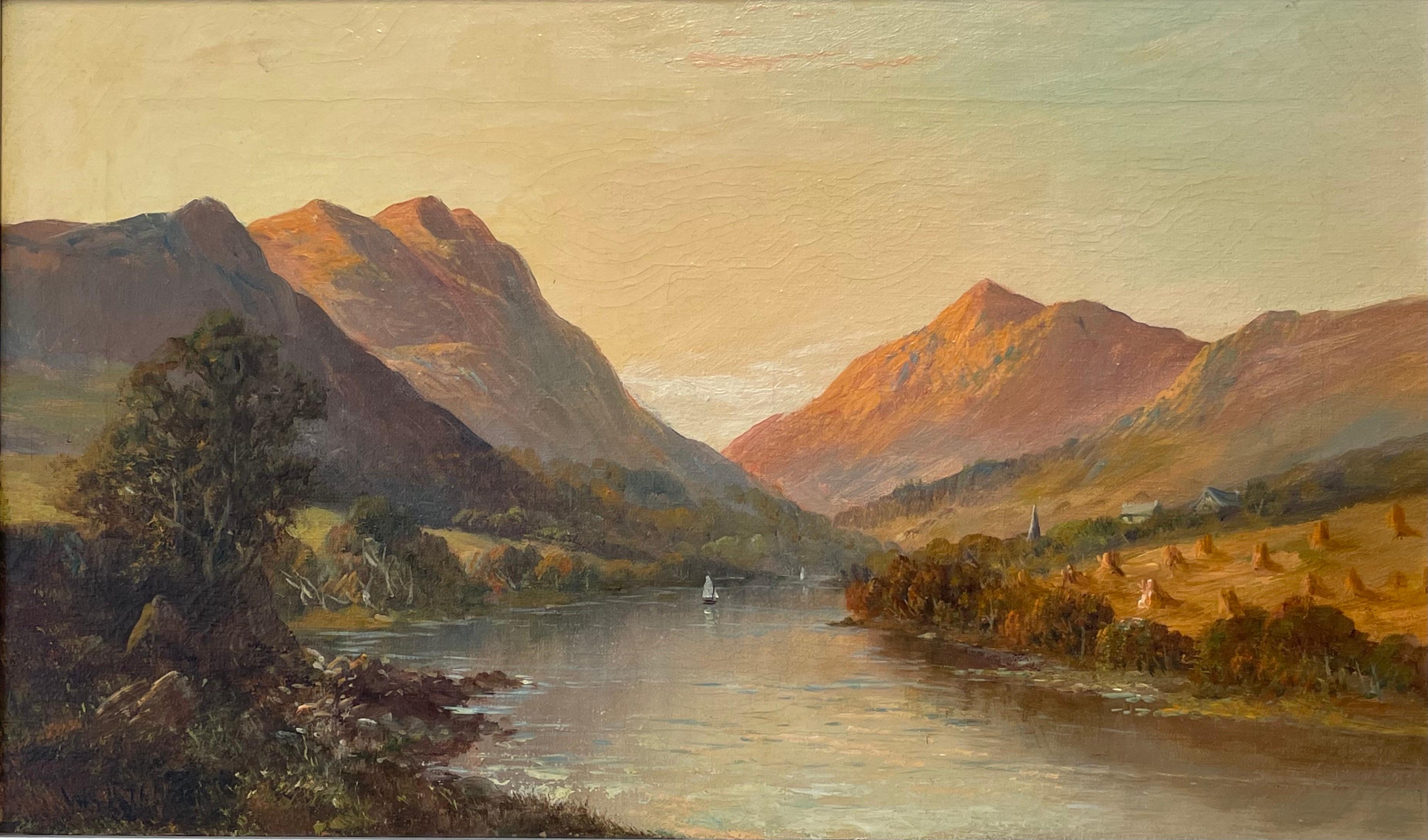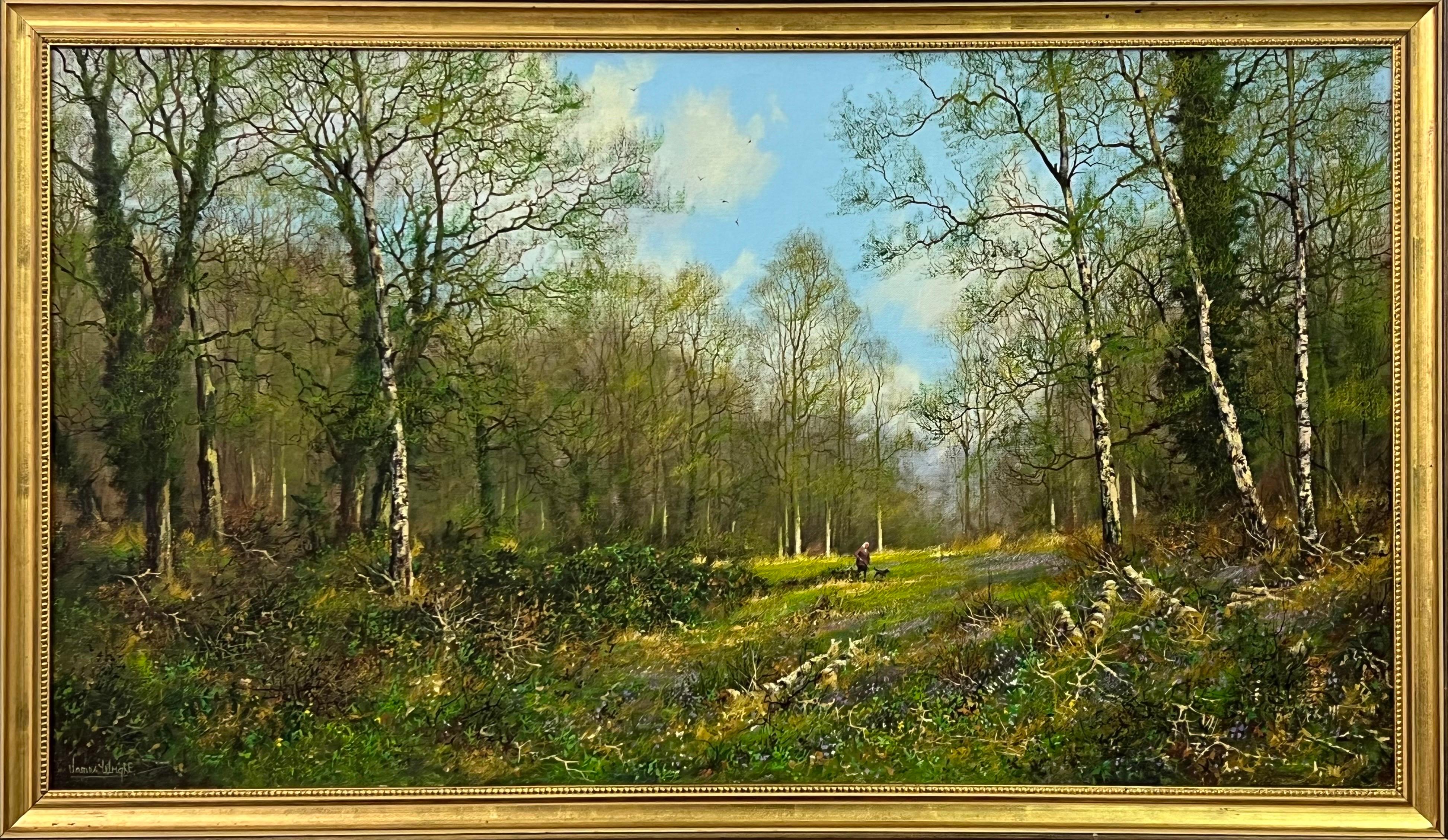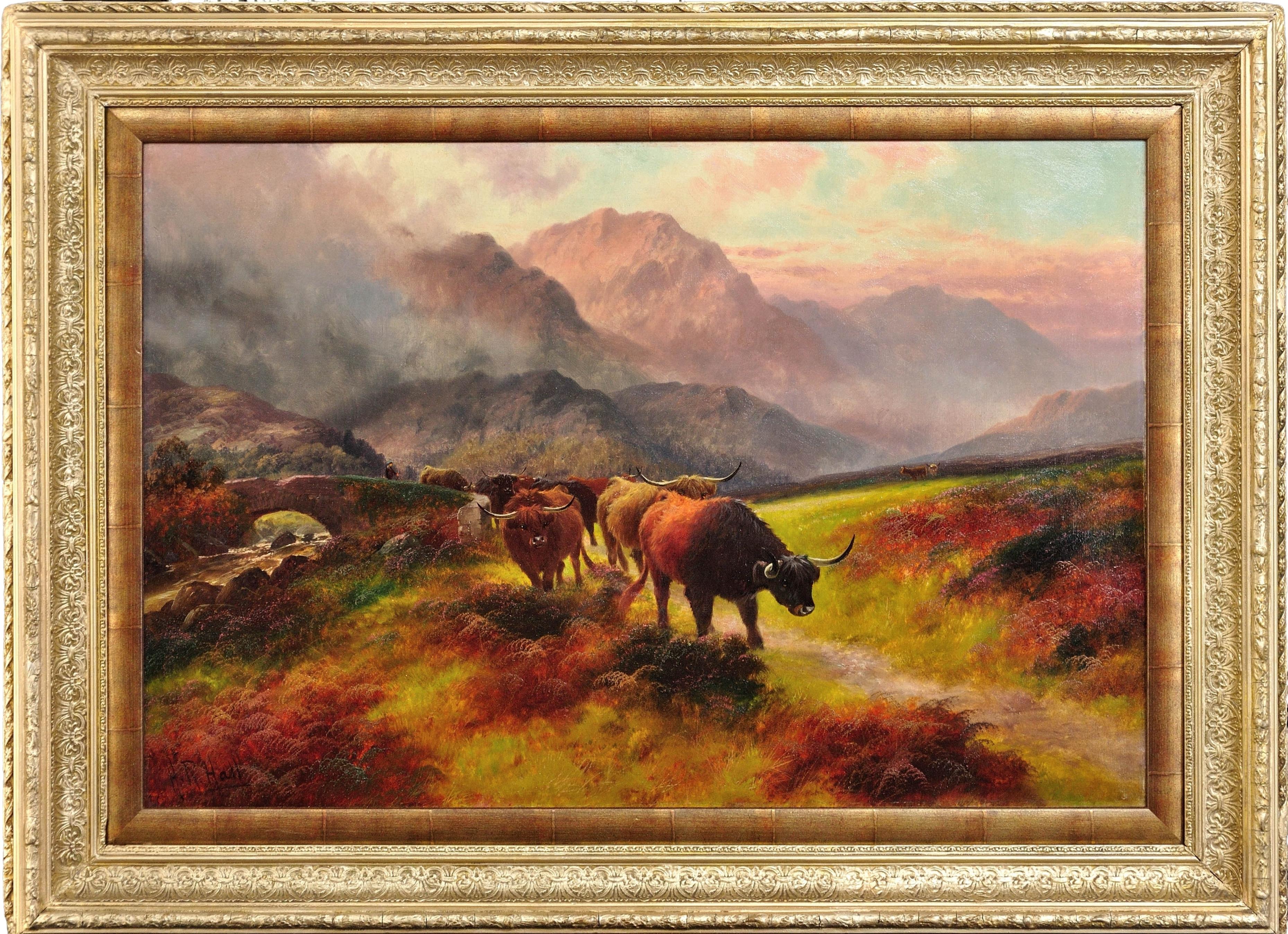Items Similar to "Gwine to Eat it All Myself" William Holbrook Beard, Bears, Animals, Genre Scene
Want more images or videos?
Request additional images or videos from the seller
1 of 8
William Holbrook Beard (1824 - 1900)"Gwine to Eat it All Myself" William Holbrook Beard, Bears, Animals, Genre Scene1894
1894
About the Item
William Holbrook Beard
Gwine to Eat it All Myself, 1894
Signed and dated lower left
Oil on canvas
16 x 24 inches
Provenance:
Childs Gallery, Boston
Cynthia Bowers, New York
Estate of the above
Exhibited:
New York, National Academy of Design, 1895, no. 405 ($500).
Literature:
American Art Review, January - February, 1975, p. 36, illustrated.
Abraham A. Davidson, The Eccentrics and Other American Visionary Painters, Boston, 1978, p. xvii.
Born in Painesville, Ohio, William Beard painted anthropomorphic, satiric genre scenes with animals engaged in human activity, and frequently bears were his symbols for human beings.
Early in his career, he was basically self-taught although he painted with his older brother, James Henry Beard. In 1845, he set up a studio in New York City, joining his brother, but his portrait skills did not earn him much money or attention. Five years later he moved to Buffalo, hoping to find more success, but he was disappointed.
From 1856 to 1858, having saved enough money to travel, he went to Europe. In Dusseldorf, Germany, he met and painted with many American artists including Emanuel Leutze, Sanford Robinson Gifford, Worthington Whittredge, and Albert Bierstadt. He also toured Switzerland and then returned to America where he again settled in New York City and took a residence studio at the Tenth Street Studio Building.
In 1866, he traveled West by train, and in Colorado his companion was Bayard Taylor, a writer and lecturer. Beard wrote to his wife, the daughter of New York portraitist Thomas le Clear, that he thought the landscape was monotonous, was disappointed he didn't see more buffalo, and was unhappy with wild life and hardship living. As a result, he turned more and more to his imagination, retaining an interest in wildlife but not in studying their habits and environment first hand. Many of his paintings showed animals, especially bears, as realistic physically but atypical in their behavior.
William Beard was elected an Associate member of the National Academy of Design in 1861, and a full member in 1862. He served on the Academy Council from 1873 to 1875. He is generally regarded as a better artist than his brother, James Beard, but both were successful during their life times.
- Creator:William Holbrook Beard (1824 - 1900) (1824 - 1900)
- Creation Year:1894
- Dimensions:Height: 24 in (60.96 cm)Width: 32 in (81.28 cm)
- Medium:
- Period:
- Condition:
- Gallery Location:New York, NY
- Reference Number:1stDibs: LU1841212373802
About the Seller
5.0
Platinum Seller
These expertly vetted sellers are 1stDibs' most experienced sellers and are rated highest by our customers.
Established in 2021
1stDibs seller since 2022
61 sales on 1stDibs
Typical response time: 1 hour
- ShippingRetrieving quote...Ships From: New York, NY
- Return PolicyA return for this item may be initiated within 3 days of delivery.
More From This SellerView All
- "Bucolic Landscape, " Sally Michel Avery, Female American Modernist Bright PastelBy Sally Michel-AveryLocated in New York, NYSally Michel Avery (1902 - 2003) Bucolic Landscape with Cows, 1963 Oil on canvasboard 9 x 12 inches Signed and dated lower left Provenance: The art...Category
1980s American Modern Landscape Paintings
MaterialsBoard, Oil, Canvas
- "Arab Scouts, " Adolph Schreyer, Middle Eastern Orientalist Scene with HorsesBy Adolf SchreyerLocated in New York, NYAdolph Schreyer (1828 - 1899) Arab Scouts, n.d. Oil on canvas 33 3/4 x 56 inches Signed lower right Housed in an exceptional period American handcarved frame Provenance: Sheridan Art Gallery, Chicago Private Collection, Chicago Traffic Club of Chicago Schreyer expert Dr. Christoph Andreas has kindly confirmed the authenticity of this work. With the increase in travel by steamship and the political involvement of European powers in North Africa and the Middle East in the nineteenth century, paintings depicting the scenery, daily life, and customs of North African and Middle Eastern people became an object of fascination among European and American audiences. The German artist Christian Adolf Schreyer...Category
Mid-19th Century Landscape Paintings
MaterialsOil, Canvas
- "The Coming Storm, " Walter Shirlaw, Flock of Birds in a LandscapeBy Walter ShirlawLocated in New York, NYWalter Shirlaw (1838 - 1909) The Coming Storm Oil on canvas 18 x 26 inches Signed lower right Exhibited: The Boston Art Club. Walter Shirlaw, born on August 6, 1838, was only three (fourteen according to one obituary) when he came to Hoboken, New Jersey from his place of birth, Paisley, Scotland. As a young man, he found work as a bank note engraver, a profession that he continued in Chicago, where he lived between 1865 and 1870. But already in 1861 he was exhibiting genre paintings at the National Academy of Design. In 1868, Shirlaw was a member of the Chicago Academy of Design, which would become the Art Institute of Chicago, after changing its name from the Chicago Academy of Fine Arts. Shirlaw spent the years 1870-77 in Munich, at the height of the movement led by Wilhelm Leibl in which a low-keyed, dark palette, combined with bold, virtuoso brushwork, were applied to realist subject matter. Michael Quick (in Quick, Ruhmer, and West, 1978, p. 28) defined the time of Shirlaw's arrival (1870-73) as an especially experimental period in progressive German painting. Shirlaw's teachers, however, sided with tradition. The genre painter Arthur Ramberg (1819-1895) and Wilhelm von Lindenschmidt (1829-1895), his successor at the Munich Academy, taught Shirlaw composition. The painter of genre scenes and landscapes, Alexander von Wagner (1838-1919) was Shirlaw's teacher in painting. T. H. Bartlett (in American Artists and Their Works, 1889, vol. 1, p. 23) mentioned that Shirlaw regarded Leibl as too realistic. Shirlaw won a scholarship at the Academy in 1874, the year in which he executed Toning the Bell (Art Institute of Chicago). Meanwhile, he was active as one of the "Duveneck Boys" in Polling. Sheep Shearing in the Bavarian Highlands (Private collection), painted under Lindenschmidt's direction in 1876, is regarded as one of Shirlaw's most important pictures. He exhibited it upon his return to America at the National Academy in the following year; in 1878, it won an Honorable Mention in Paris. In 1877, the second school year of the Art Students League, Lemuel E. Wilmarth announced that he would be returning to teach at the NAD. Frank Waller (1842-1923) took over as president of the ASL, and Shirlaw was hired to teach painting and drawing. The appointment was endorsed by Waller: "In Munich . . . he was regarded as one of the strongest of the American students and had the strong personality which would attract and influence others to have confidence in him, was so genuine in his artistic impulses and in his interest in the development of art in this country. . . ." (quoted by Landgren, 1940, p. 32). The hiring of Shirlaw and William Merritt Chase seemed to signify a preference of Munich over Paris among the members of the Art Students League, however, while Chase was under Leibl's spell, Shirlaw was strictly academic. During the fourth season at the ASL, Shirlaw taught composition. Thomas Wilmer Dewing...Category
Late 19th Century Impressionist Landscape Paintings
MaterialsCanvas, Oil
- "Crane, " Decorative Japanese School Painting of White BirdLocated in New York, NYJapanese School Crane Oil on paper, laid on Masonite 59 1/2 x 47 inches Signed in JapaneseCategory
20th Century Animal Paintings
MaterialsMasonite, Paper, Oil
- "Interior of a Stable" William Hart, Hudson River School Antique, Boy and HorseBy William HartLocated in New York, NYWilliam M. Hart (1823 - 1894) Interior of a Stable Oil on canvas 17 x 12 inches Provenance William Macbeth Gallery, New York Mrs. Mabel Brady Garvan Collection Christie's New York, Sporting Art, November 28, 1995, Lot 116 Ann Carter Stonesifer, Maryland Estate of above Brunk Auctions, Asheville, North Carolina, January 27 2018, Lot 777 Exhibited New York, The Metropolitan Museum of Art, Life in America, April 24 - October 29, 1939, no. 123, illustrated. New York, Macbeth Gallery, 1892: Sixtieth Anniversary Exhibition, April 1952, p. 5, no. 18. Literature Turner Reuter Jr, Animal and Sporting Artists in America, Middleburg, Virginia, 2008, p. 306. Gary Stiles, William Hart: Catalogue Raisonné and Artistic Biography, no. 1126, illustrated. It should be noted that the Francis Patrick Garvan and Mrs. Mabel Brady Garvan collection, of which this painting was a part of, was one of the foremost American Art collections and now makes up a large part of the Smithsonian American Art Museum and the Yale University Art Gallery collections. Born in 1823 in Paisley, Scotland, William Hart emigrated with his parents to the United States at the age of nine and settled in Albany, New York. It was here that Hart first began his artistic training when he was placed under the tutelage of Messrs, Eaton & Gilbert, the prestigious coach-makers from Troy, New York. During this time, Hart learned how to decorate coach panels, covering them with either landscapes or figurative compositions. At the age of seventeen, he was eagerly contemplating an artist’s profession. Consequently, he left the mechanical trade of coach-making and began expanding his artistic pursuits to more refined endeavors. Hart followed coach-making with decorating window shades and later developed an interest in portraiture. Around 1840, he established his first formal studio in his father’s woodshed in Troy. There, he created many likenesses of individuals, affording him a nominal income. Once, he remarked that he felt prouder over his first fee of five dollars for painting a head then for the larger sums he would command later in his career. Nevertheless, his wages from portraits during this early period proved insufficient. Thus, he expanded into landscape painting, allowing him to barter his works or sell them for modest prices. In 1842, Hart moved to Michigan in an attempt to further his success; portraiture remained his primary means of support. Unfortunately, his experiences in the West were disappointing. Hart spent three years living a rough existence until he finally returned to Albany in 1845. Upon his return, he fully devoted himself to the art of landscape painting. Despite his failing health, he worked diligently to perfect his skill until 1849 when he traveled abroad to his native land of Scotland. This trip was made possible through the generosity of his patron and advisor, Dr. Ormsby of Albany. For three years, he studied in the open-air, creating brilliant sketches of the Scottish Highlands and the surrounding British Isles. Returning to Albany once more in 1852, Hart enjoyed improved health and was reinvigorated with purpose. The following year, he moved to New York and opened a studio, promoting himself as a specialist in landscape painting. Hart became a regular contributor to the National Academy of Design. His works received a great deal of attention from artists and connoisseurs alike, all of whom praised him for his fresh, self-taught style. In 1855, he was designated as an associate of the National Academy of Design; three years later he was elected to Academician. In 1865, he was unanimously chosen to be the first president of the Brooklyn Academy of Design. It was during his tenure there that he delivered his famous lecture The Field and Easel, which emphasized the distinguishing principles of landscape art in America. Hart argued that landscape painters should express the “look of the place” being depicted.Critics during the 1870s noted his sensitive balance between capturing a strict “real” interpretation of nature and that of a more “ideal” sentimental tone. For instance, in 1869, Putnam Magazine noted that Hart brought back “exquisite studies” of the surrounding Tappan...Category
19th Century Hudson River School Animal Paintings
MaterialsCanvas, Oil
- "African Elephant Walking, " Spencer Hodge, Safari Wildlife Animals, RealismLocated in New York, NYSpencer Hodge (British, b. 1943) African Elephant Walking Oil on canvas 38 x 50 1/2 inches Signed lower right Spencer Hodge attended the Hastings School...Category
Late 20th Century Realist Animal Paintings
MaterialsCanvas, Oil
You May Also Like
- Traditional English Farm with Horses, Figures, Trees & Lake by British ArtistLocated in Preston, GBEnglish Farmhouse with Horses, Figures, Fields, Trees & Lake entitled 'Winters Morn' by 20th Century British Artist. Art measures 36 x 24 inches Frame measures 41 x 30 inches Ch...Category
Late 20th Century Photorealist Landscape Paintings
MaterialsCanvas, Oil
- Antique Scottish Highlands Signed Oil Painting Summer Loch Sunset Harvest FieldBy Francis E. JamiesonLocated in Cirencester, Gloucestershire"Aberfeldy" by F. E. Jamieson (British 1895-1950) signed, lower corner with pseudonym "W. Richards" titled verso to canvas oil painting on canvas, framed canvas: 12 x 20 inches fra...Category
Early 20th Century Victorian Landscape Paintings
MaterialsOil, Canvas
- Sunset over Mountain Lakes Cattle Watering from Water Large Tranquil Oil CanvasLocated in Cirencester, GloucestershireEnglish School, late 20th century oil on canvas, framed framed: 23 x 30 inches canvas: 16 x 24 inches provenance: private collection, England the painting is in overall very good and...Category
Late 20th Century Victorian Animal Paintings
MaterialsCanvas, Oil
- Dog Walk in a Silver Birch Woodland in the English Countryside by British ArtistBy James WrightLocated in Preston, GBOil Painting of a Dog Walk in a Silver Birch Woodland in the English Countryside, by 20th Century Modern British Artist, James Wright Art measures 30 x 16 inches Frame measures 36 ...Category
Late 20th Century Realist Landscape Paintings
MaterialsCanvas, Cotton Canvas, Oil
- Glen Menteith – Highland Cattle. Scottish Cows. Victorian. Scotland. Large Oil.Located in Sutton Poyntz, DorsetHenry Robinson Hall. English ( b.1857 - d.1927 ). Glen Menteith, Scotland – Highland Cattle. Oil on Canvas. Signed lower left. Also signed and titled on the reverse. Image size 23.6 ...Category
Late 19th Century Naturalistic Animal Paintings
MaterialsCanvas, Oil
- Farm Track in Wooded Landscape with Pink & Green by 20th Century British ArtistBy Wyn ApplefordLocated in Preston, GBFarm Track in Wooded Landscape with Pink & Green by 20th Century British Artist, Wyn Appleford (British, 1932-2020). Presented in a high quality black wo...Category
1980s Realist Landscape Paintings
MaterialsCanvas, Oil
Recently Viewed
View AllMore Ways To Browse
William Holbrook Beard
Robinson Sanford Gifford
Worthington Gallery
Atypical Finds
E Herberte
Faust Cow
Ferdinand Schebek
Fourth Dimension Slonem
Francois Duyck
Frank Moss Bennett On Sale
Gary Miller On Sale
George Augustus Holmes
George Riecke
Gheorghe Fikl
Gordon Wylie
Grant Hacking On Sale
Gustave Surand On Sale
Henry Botkin On Sale





